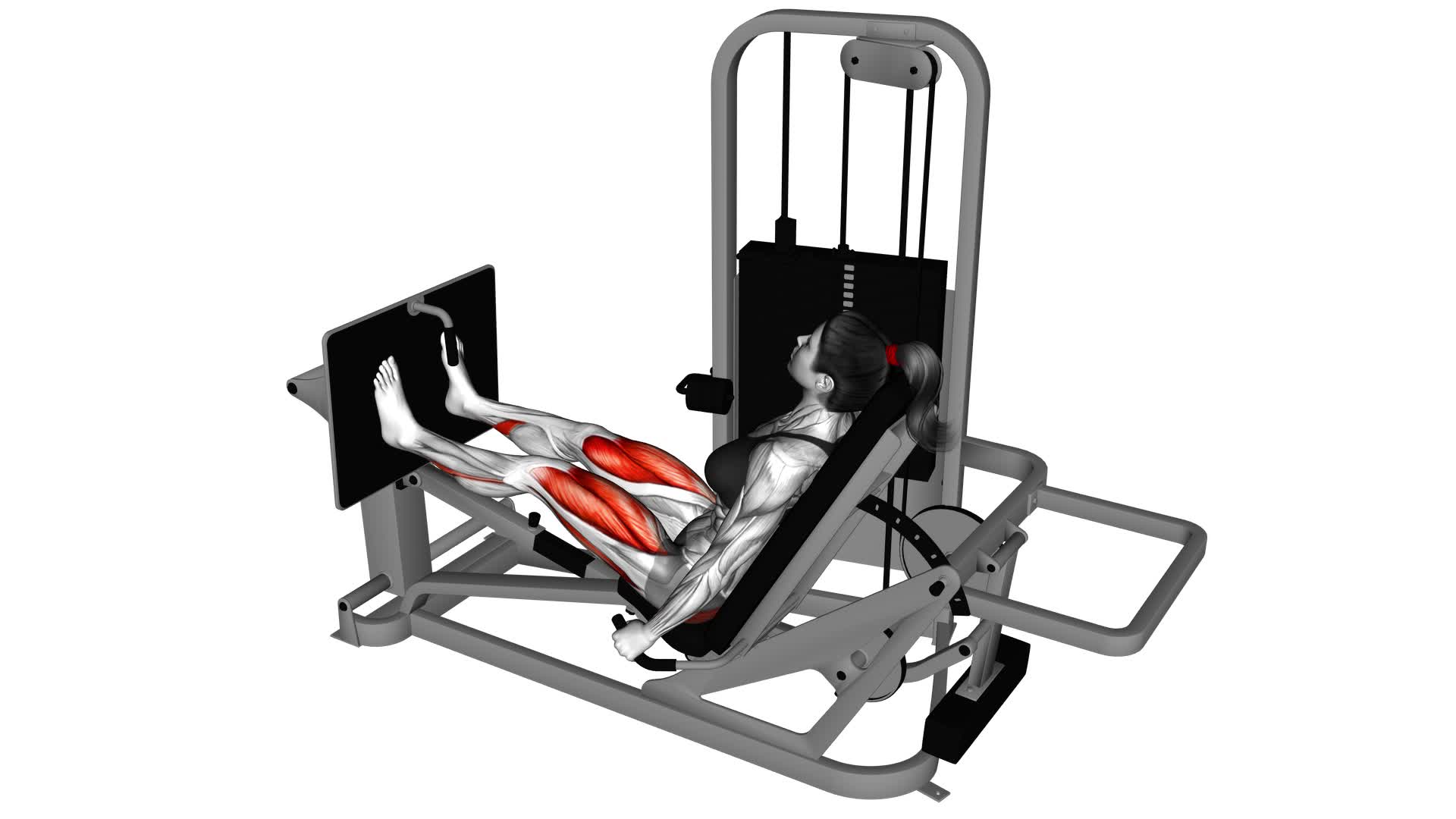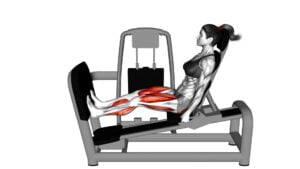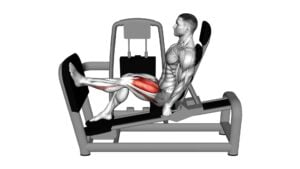Lever Seated Leg Press (female) – Video Exercise Guide & Tips

Are you looking to strengthen and tone your legs?
Watch This Exercise Video
The lever seated leg press is a great exercise for you. This video exercise guide will show you the proper form and provide tips to target specific leg muscles.
You'll learn how to adjust the weight and seat position for optimal results. Plus, we'll give you tips for increasing intensity and progressing in the leg press.
Avoid common mistakes and get the most out of your workout with this informative guide.
Key Takeaways
- Proper form and set up are essential for a successful leg press exercise.
- Adjusting foot placement on the footplate can target specific leg muscles.
- Seat position and weight adjustment are important for customization and targeting specific muscles.
- Gradually increasing weight and incorporating different foot placements can increase intensity and promote muscle growth.
Proper Form for Lever Seated Leg Press
To perform the Lever Seated Leg Press correctly, position yourself on the machine with your feet firmly planted on the footplate. This exercise is a great way to target your leg muscles and build strength.
However, there are some common mistakes that people often make when using the leg press machine.
One common mistake isn't setting the seat and footplate at the correct height. Ensure that your knees are at a 90-degree angle when your feet are on the footplate. This will help you maintain proper form and prevent injury.
Another common mistake is using too much weight. Start with a weight that allows you to perform the exercise with good form and gradually increase the weight as you get stronger. Using too much weight can put unnecessary strain on your joints and increase the risk of injury.
Now let's talk about the benefits and variations of the Lever Seated Leg Press. This exercise primarily targets your quadriceps, hamstrings, and glutes. It helps to improve leg strength, increase muscle size, and enhance overall lower body power. Additionally, there are variations of the leg press that you can try, such as single-leg presses or wide stance presses, to target different muscles and add variety to your workout routine.
In the next section, we'll discuss how the leg press can be used to target specific leg muscles.
Targeting Specific Leg Muscles With the Leg Press
To target specific leg muscles with the leg press, focus on adjusting your foot placement and seat position. Here are some tips to help you get the most out of your leg press workout:
- Position your feet wider apart to target your inner thighs and glutes. This variation is known as the wide stance leg press.
- Place your feet closer together to target your quadriceps. This variation is called the narrow stance leg press.
- Place your feet high on the footplate to target your hamstrings and glutes. This is known as the high foot placement leg press.
- Position your feet low on the footplate to target your quadriceps. This is called the low foot placement leg press.
- Adjust the seat position by moving it closer or farther away from the footplate. Moving it closer will target your quadriceps, while moving it farther away will target your glutes and hamstrings.
By incorporating these leg press variations and adjusting your foot placement and seat position, you can effectively target different leg muscles. The leg press offers several benefits, including increased leg strength, improved muscle tone, and enhanced overall lower body development.
Adjusting the Weight and Seat Position for Optimal Results
Adjust the weight and seat position on the leg press machine to optimize your results. When it comes to adjusting the seat position, it's important to find a setting that allows your knees to bend at a 90-degree angle when your feet are on the footplate. This will ensure proper alignment and prevent strain on your joints. To adjust the seat height, simply release the locking pin and move the seat up or down until you find the right position. Remember to re-lock the pin securely before starting your workout.
In addition to adjusting the seat position, you should also consider varying your leg press exercises to target different muscles. By changing the foot placement on the footplate, you can emphasize different muscle groups. For example, placing your feet higher on the footplate will target your glutes and hamstrings, while placing them lower will target your quads. You can also try different foot widths to target different areas of your legs.
Tips for Increasing Intensity and Progressing in the Leg Press
To increase the intensity and progress in the leg press, focus on gradually increasing the weight you're lifting. This will help challenge your muscles and promote growth. However, it's important to do this in a safe and controlled manner to avoid injury.
Here are some tips to help you increase the intensity and progress in your leg press workout:
- Increase resistance: Gradually add more weight to the leg press machine as you become stronger. Aim to increase the resistance by 5-10% each week to continue challenging your muscles.
- Change foot placement: Altering your foot position on the leg press machine can target different muscles in your legs. Experiment with placing your feet wider or narrower, or even higher or lower on the footplate to engage different muscle groups.
- Perform drop sets: After completing your regular sets, lower the weight and continue performing more repetitions until fatigue. This technique helps to further fatigue your muscles and stimulate growth.
- Incorporate supersets: Pair the leg press exercise with another leg exercise, such as lunges or squats, to increase the intensity and challenge your muscles in different ways.
- Focus on proper form: It's essential to maintain proper form throughout the leg press exercise. Keep your back flat against the seat, your knees tracking in line with your toes, and avoid locking out your knees at the top of the movement.
Common Mistakes to Avoid During the Lever Seated Leg Press
Avoid these common mistakes to ensure proper form and maximize the effectiveness of your lever seated leg press workout.
Proper form is crucial to avoiding injury and getting the most out of your exercise. One common mistake is using too much weight. It's important to start with a weight that you can handle comfortably and gradually increase it as you get stronger.
Another mistake isn't maintaining proper breathing techniques. Remember to exhale as you push the weight away from you and inhale as you bring it back towards your body. This helps to stabilize your core and provides support to your muscles.
Additionally, avoid locking your knees at the top of the movement. Locking your knees can put unnecessary strain on your joints and increase the risk of injury. Instead, keep a slight bend in your knees throughout the exercise.
Finally, make sure your feet are placed correctly on the footplate. They should be hip-width apart and positioned firmly on the plate to ensure stability.
Frequently Asked Questions
How Long Should I Rest Between Sets When Performing the Lever Seated Leg Press?
Rest time between sets is an important factor when performing the lever seated leg press. It allows your muscles to recover and prevents injury.
The optimal rest time varies depending on your fitness level and goals. Generally, a rest period of 1-2 minutes is recommended for strength training. However, if you're focusing on muscular endurance, shorter rest times of 30-60 seconds may be more suitable.
Always listen to your body and make any necessary modifications to avoid injury.
Can I Perform the Lever Seated Leg Press if I Have a Previous Knee Injury?
Yes, you can still perform the lever seated leg press with a previous knee injury, but it's important to proceed with caution. Make sure to consult with a healthcare professional or physical therapist before attempting this exercise. They can provide guidance and modifications to ensure your safety.
If the leg press isn't suitable for your knee injury, there are alternative exercises such as squats, lunges, or step-ups that can help strengthen your lower body without putting excessive strain on your knees.
How Many Sets and Repetitions Should I Do When Incorporating the Lever Seated Leg Press Into My Workout Routine?
To determine the number of sets and repetitions for the lever seated leg press, consider your workout intensity and maintaining proper form.
It's crucial to find a balance between challenging yourself and avoiding injury. Start with a moderate workload, such as 3 sets of 10 repetitions, and gradually increase the intensity as your strength improves.
Remember to listen to your body and adjust the numbers accordingly.
Focus on maintaining proper form throughout the exercise to maximize its benefits.
Is It Normal to Feel Discomfort in My Lower Back While Performing the Lever Seated Leg Press?
Feeling discomfort in your lower back during the lever seated leg press isn't normal. It could be due to improper form and technique. Make sure you're positioning yourself correctly and using the machine in a way that supports your lower back.
Focus on maintaining a neutral spine and avoid rounding your back. If the discomfort continues, it's important to consult a fitness professional for guidance and further evaluation.
Can I Use the Lever Seated Leg Press as a Substitute for Squats in My Leg Workout Routine?
Yes, you can use the lever seated leg press as a substitute for squats in your leg workout routine. The lever seated leg press offers similar benefits to squats, such as targeting your quadriceps, hamstrings, and glutes.
It's a convenient alternative for individuals with lower back discomfort or mobility limitations. However, it's important to maintain proper form and adjust the weight accordingly to avoid straining your muscles or joints.
Always consult with a fitness professional for personalized guidance.
Conclusion
In conclusion, the lever seated leg press is an effective exercise for targeting specific leg muscles. By maintaining proper form, adjusting the weight and seat position, and following tips for increasing intensity, you can optimize your results.
It's important to avoid common mistakes during the exercise to prevent injury and maximize the benefits.
Incorporating the lever seated leg press into your workout routine can help you build strength and improve leg muscle definition.

Author
Years ago, the spark of my life’s passion ignited in my mind the moment I stepped into the local gym for the first time. The inaugural bead of perspiration, the initial endeavor, the very first surge of endorphins, and a sense of pride that washed over me post-workout marked the beginning of my deep-seated interest in strength sports, fitness, and sports nutrition. This very curiosity blossomed rapidly into a profound fascination, propelling me to earn a Master’s degree in Physical Education from the Academy of Physical Education in Krakow, followed by a Sports Manager diploma from the Jagiellonian University. My journey of growth led me to gain more specialized qualifications, such as being a certified personal trainer with a focus on sports dietetics, a lifeguard, and an instructor for wellness and corrective gymnastics. Theoretical knowledge paired seamlessly with practical experience, reinforcing my belief that the transformation of individuals under my guidance was also a reflection of my personal growth. This belief holds true even today. Each day, I strive to push the boundaries and explore new realms. These realms gently elevate me to greater heights. The unique combination of passion for my field and the continuous quest for growth fuels my drive to break new ground.



